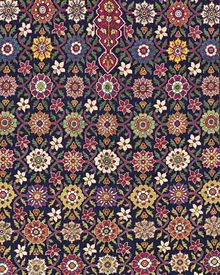Azerbaijani Carpet
| Azerbaijani Carpet | |
|---|---|
 | |
| General information | |
| Name | Azerbaijani Carpet |
| Original name | فرش آذربایجان، قالی آذربایجان |
| Alternative name(s) | Azerbaijani Rug |
| Origin | |
| Technical information | |
| Common designs | Geometric |
| Knot type | Symmetrical (Turkish) |
Azerbaijani Carpet or Azerbaijani Rug is one of the eastern rugs that woven in Azerbaijan.
A large region south of the Caucasus mountains and west of the Caspian Sea, now divided by the River Aras (Araxes) into the Republic of Azerbaijan (north) and the Iranian province of Azerbaijan (south). Tabriz is a major city and rug production center of Iranian Azerbaijan. Rug production centers in the Republic of Azerbaijan include Kuba, Karabagh, Shirvân, and Baku. Azerbaijan is inhabited by Turks who are currently (or formerly) Shi’i Muslim in religion, but the population also includes Shi’i Persians, Sunni Kurds, and Christian Armenians and Assyrians.
Carpet production was primarily for domestic use until the mid-nineteenth century. In the last quarter of the nineteenth cen tury and early twentieth century, carpet production was a major export industry. Turkey was the largest importer of Azerbaijanian carpets throughout this period. Pile rugs of Azerbaijan are primarily Turkish knotted.
There is a group of Azerbaijan embroidery dating back to the seventeenth century, primarily from northern Azerbaijan. The foundation fabric is cotton and the embroidery is usually in silk. Often, these embroideries have a squareish format. They were usually used as kerchiefs. Most designs are similar to those of early Caucasian floral carpets. Designs of compact roundels, stars, and cartouche shapes are also common. Many nineteenth-century rug designs appear to have been developed or adopted from such embroideries (Swastika Kazak, Star Kazak, Karagashli, etc.).
A wide variety of bags, animal trappings, and flatweaves are produced in Iranian Azerbaijan. The structures used are kilim, soumak, cicim, and embroidery.[1]
History
Azerbaijan is a region located in a large part of the eastern Caucasus region and northwestern Iran. The majority of the population is Azeri tribe in origin, speaking a Turkic dialect. For centuries much of Azerbaijan belonged to Persia, but in 1813 the northern portion of Azerbaijan was transferred to the Russian Tsarist Empire under the Treaty of Gulistan that was brokered by the British. In 1828 the British again assisted in a second agreement, named the Treaty of Turkmanchai, allowing the Russian Tsar to occupy the rest of Azerbaijan in the Caucasus region, the area north of the Aras River. Today Azerbaijan remains separated into two areas, known as the Azerbaijan Caucasus and the Azerbaijan Iran regions.
Azerbaijan rugs from as early as the seventeenth century appear in the market. Their geometric style continues even into the modern period. In Azerbaijan, hundreds of towns and villages produce carpets that are popular for their beautiful folk art designs. Antique Azerbaijan rugs and carpets can be found in museums throughout the world. In addition, collectors and consumers appreciate the designs and coloration, paying high prices for older Azerbaijan rugs. Among the best known Azerbaijan Caucasian rugs are the Baku, Daghestan, Kuba, Moghan, Shirvan, and Talish from the eastern portion of the Caucasus region. In the central and western areas are the notable weaving centers of Gendje, Karabagh, and Kazak. Notably, the Karabagh region produced embroideries in folk art designs dating from the seventeenth century. These embroideries are charming in appearance and are rare in the antique market. Collectors and museums try to obtain these marvelous artifacts.
The second-most well-known Azerbaijan region in northwestern Iran is famous for The Ardebil Carpets, dating to the sixteenth century. Notable Tabriz carpets from the sixteenth and seventeenth centuries are on view in museums throughout the world. These carpets have floral patterns with medallion and allover designs and Safavid motifs of palmettes, leaves, birds, and animals. The Hunting design was also used for Tabriz carpets. These traditional designs have continued to be made up to the present in Tabriz and other Azerbaijan cities. In Iranian Azerbaijan, most villages and towns are known for weaving geometric folk art rugs and carpets. These rugs range from small tribal pieces to large room sizes. Originally, room dimensions were rare in folk art weavings but soon saw demand in Western markets. Some villages were known to weave room-size carpets from the late eighteenth and early nineteenth centuries, such as Bakshaish, Heriz, Karadja, and Sarab, among others. These carpets play an important role in the antique and designer markets because only here were folk art designs woven in larger sizes.
In Azerbaijan an important rug type is the silk Heriz, which is in high demand by collectors, who pay top prices. Other Azerbaijan collectible items are the rare embroideries made in the South Caucasus region and Shahsavan tribal rugs. Both are famous for their folk art designs and coloration. These weavings are also in high demand by collectors and museums in the worldwide antique market. Rug and carpet weaving in both Azerbaijan regions supplied important income for families during the last four centuries.[2]
References
Bibliography
- Abraham Levi Moheban. 2015. The Encyclopedia of Antique Carpets: Twenty-Five Centuries of Weaving. NewYork: Princeton Architectural Press.
- Peter F. Stone. 2013. Oriental Rugs: An Illustrated Lexicon of Motifs, Materials, and Origins. North Clarendon: Tuttle.